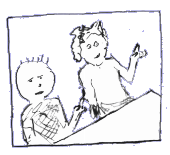




| |
Fuzzy logic is based on the idea that A can equal not-A. That means that something can contain a part of its opposite. That's what the woman in the fairy-tale meant when she said that if you look at the problem with fuzzy logic, the dragon is lying (A) and not lying (not-A) at the same time.
 Let's look at the school problem once more, this time using fuzzy logic. We
already know that we can easily state that a kid likes school and doesn't like school
at the same time. That's still not very accurate though, since one kid may
like school more than he doesn't, while another one hates it more than he doesn't.
For this we use
fuzzy truths.
Fuzzy truths are a way to notate to what degree something contains A and to
what degree it contains not-A. Usually, we write fuzzy truths in the form of percent. So
we can now say, one kid likes school to 75% and doesn't like it to 25%, while another one likes
school to 45% and doesn't like it to 55%. Fuzzy truths always have to add up to 100%.
Let's look at the school problem once more, this time using fuzzy logic. We
already know that we can easily state that a kid likes school and doesn't like school
at the same time. That's still not very accurate though, since one kid may
like school more than he doesn't, while another one hates it more than he doesn't.
For this we use
fuzzy truths.
Fuzzy truths are a way to notate to what degree something contains A and to
what degree it contains not-A. Usually, we write fuzzy truths in the form of percent. So
we can now say, one kid likes school to 75% and doesn't like it to 25%, while another one likes
school to 45% and doesn't like it to 55%. Fuzzy truths always have to add up to 100%.
Of
course, it doesn't make much sense to describe how much one likes school
with numbers, since it isn't that clear, but it certainly makes more sense than only
having the extremes of loving and hating school.
